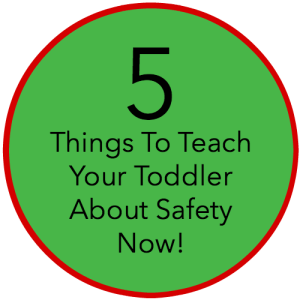
You’re a new parent, your child is growing faster than you imagined possible – cooing, then saying words, using a spoon, potty training, and before you know it she’s walking! During these adorable toddler years, nursery rhymes and ABCs are important and obvious things to teach your child but don’t let ABCs and cute songs be your only teaching moments as a parent of a toddler. Even before your child learns to speak you need to consider what you are going to teach your child about safety. Below are a few things you can and should teach your toddler or preschooler that will help him or her in an emergency situation and keep lines of communication open.
5 Important Safety Tips To Teach Your Toddler or Preschooler Now!
- Teach your child his/her full name, address and telephone number
Your toddler should be able to tell an adult his or her full name, address, and phone number when asked. It is important that your child also know when and when not to give that information. For example, teach your child not to share this information with a stranger who walks into your front yard, but that he or she should give the information to a police officer, teacher, or other official if she is lost in public.
- Teach your child how to call 911
Your child should be taught how to call 911 in case a parent, caregiver, or sibling is injured or sick. Also teach your child to never dial 911 unless there is an emergency. If you have a security lock on your phone’s home screen, teach your child how to unlock it so she can access 911. Make sure she can go through the steps completely, without actually dialing 911.
- Teach your child what is appropriate and what is not
As parents, we have the responsibility of teaching our children how to be safe and to know what is safe and what is not. A child’s response to emergency situations will depend on how your child was taught to react to these circumstances. You should also teach your child that being touched on the private parts by an adult other than a parent, trusted caregiver, and doctor is not appropriate or acceptable. Teach your child how to react. Your child should be taught to never fear keeping the lines of communication open between you and other trusted adults, so he/she can freely ask about things that concern or confuse her and share her fears.
- Teach your child how to behave in the car
Did you know that one of the worst driving distractions on the road is kids? It is very important to teach your child that you can not be distracted while driving. This is going to require mental effort on your part! We know how difficult it is to ignore a child who is crying because she dropped her sippy cup. Do not turn around to pick the sippy cup or toy up yourself! If you must get the cup for your child, pull into a parking lot and come to a stop before doing so. Your child should be taught to keep a quiet tone in the car, no screaming allowed, no throwing toys, and no kicking the seat.
We recommend installing a backseat organizer on the seatback in front of your child so he or she can access everything they need.
- Make sure your child knows their safety is very important to you
We’re not suggesting that your child should live in fear. Don’t paint an ugly picture of the world, but make your child aware that there are indeed bad guys out there and they don’t necessarily look bad. That is one of the biggest misconceptions children have about bad guys. Letting your child think the world is like their fairytale books and that they are safe all the time is not the best way to teach child safety. That could make your child put down their guard, making her an easy target of abductor and/or sexual offender. Let your child learn how to listen to his or her instincts and act on those.
Educate your child on how to use his or her fears to benefit him or her. Children who have been taught how to act on emergency situations will be able to handle their fears well. Teach your child to trust their instincts to help them get out of trouble.
One of the most efficient ways to teach child safety is to be consistent and firm in disciplining the children. Give your child clear views on things related to safety and rules should be firm. Bending these rules will make them think that anything else can be haggled, especially when it comes to car-riding safety. This belief will compromise your child’s safety. Your child should have a general understanding of the rules and the corresponding punishments, if disobeyed. A firm but gentle reprimand and an explanation will give your child a clear idea that you mean what you say. Mutual respect follows, creating a more conducive atmosphere for ways to teach your child safety tips and rules.



